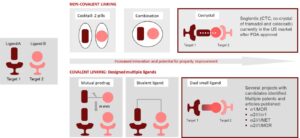Carmen Almansa, José Luís Díaz, Mónica García, Adriana Port, José Miguel Vela
Welab Barcelona, Parc Científic Barcelona, C/ Baldiri Reixac 4-8, 08028 Barcelona, Spain
Many pathological states are multimodal in nature involving several molecular mechanisms and monomodal therapies often fail to provide complete relief or show undesirable side effects. Multimodal Therapy may be a way of improving this scenario and among the several approaches described to achieve compounds with a dual profile (see Figure 1) dual small ligands are the best since they offer the potential of improving the efficacy and safety ratio, broadening the therapeutic application in relation to mono-mechanistic drugs and decreasing the risk of drug-drug interactions compared to cocktails or multi-component drugs, thus involving simpler pharmacokinetics and less variability among patients.

Figure 1. Approaches to Multimodal Therapy
Welab MedChem team is highly experienced in achieving drug-like multimodal compounds acting on any target class and we describe here two case examples:
▪ The identification of WLB-73502, a dual σ1 receptor (σ1R) and μ-opioid receptor (MOR) ligand, that is currently ready for Phase II clinical trials. In preclinical models it displays similar nociceptive pain relief, better neuropathic pain relief, improved tolerability, less respiratory depression, and less abuse potential than strong opioids, confirming the potential of the dual approach for improving the standard of care in the treatment of pain.
▪ The discovery of two dual leads (WLB-77166 and WLB-79657) acting at the α2δ-1 subunit of voltage-gated calcium channels (Cavα2δ-1) and at the norepinephrine transporter (NET, SLC6A2), two mechanisms with clear rationale in the treatment of pain.


